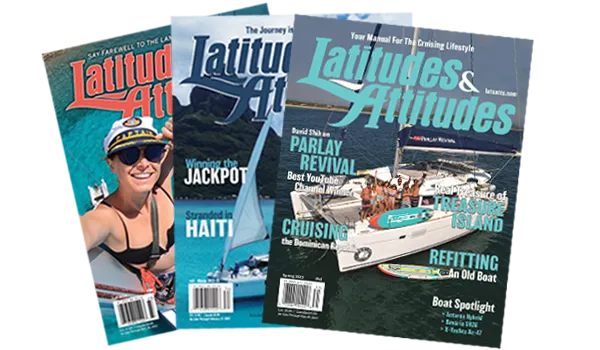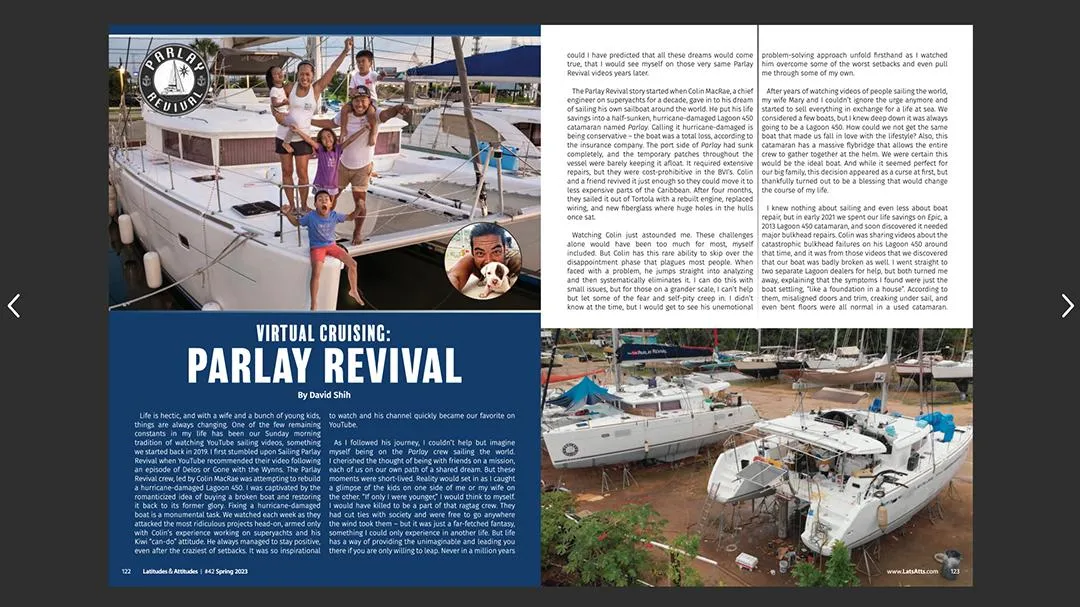Pets Aboard
By Teri Miller
When people meet Charlie, our furry first mate, they often ask, “Does he love being on the boat?” I once thought the best answer to this question was, “Yes, of course!” He enthusiastically jumps aboard, loves standing with his nose in the fresh air, has well-established favorite spots for napping, abundant treats, and toys, dolphins to bark at, dinghy rides, and an endless supply of attention. What is not to love? The real response, though, should be that while he may enjoy boat life, what he truly loves is being with us. The feeling is mutual. We love having him with us on the boat.
No matter where we ventured, we found Charlie to be a great social connector. Strangers, some with dogs, others without, would easily engage with us, asking about Charlie and eager to share their own stories. Some of our dearest friendships came from meeting other boaters who also enjoyed the company of dogs aboard. Another benefit of having a pet on board is boat security. If you knew Charlie, you would laugh at the idea of him protecting anything other than his favorite toy, but a pet onboard can be a deterrent to someone looking for an easy way to disturb your property. The greatest value of boating with pets is companionship. The boating life can be as social or as isolated as you prefer, but a boat dog (or cat) can certainly keep you company while challenging you to explore beyond your boat.
The benefits of having Charlie with us far outweighed all the work that it required…but it did require work. Whether you are out for a short cruise or a longer liveaboard journey, boating with pets brings additional boxes to check before getting underway.
All Aboard
Safety is a priority for all crew members, and that includes your pets. It is important to give thought to how your pet will get on or off your vessel. For some, your pet may be small enough to carry, but if your pet is larger you need to have a plan. Well-maintained floating docks are pet friendly but not always an option. Depending on your hull design and location for boarding, you may be lifting your pet up or over a freeboard or onto a swim platform. A good harness is important. Unlike a collar, which could cause a choking hazard when pulled, a harness allows you to assist your pet as needed in getting aboard. Should your dog or cat make an unexpected water entry, having a harness with a handle will make retrieving them much safer. When choosing a harness, consider if it can hold the weight of your dog or enable a boat hook to snag it if needed. If your pet will have access to areas of your boat in which they can get overboard, keeping them in a comfortable life vest is important. We may be lulled into a false sense of safety if our pets are good swimmers or water-loving breeds, but a life vest will give you valuable time to assess and safely retrieve your pet. Some boarding circumstances require extra consideration, such as dinghy entry, fixed docks, or ladder-only accessibility. Ingenuity and forethought will be your best friends in these situations. We have found giving Charlie a command to the board helpful. When needing to take a step across a space from a dock or dinghy to the boat, hesitation tends to cause problems for pets and people alike. We use one word, “board!” for when Charlie must step/jump/or be helped on or off a boat. He is more confident boarding when he is obeying a command. In the event of an unplanned water entry, or even if a swimming excursion was intended, you will want a plan for getting back aboard. This is especially important for larger or older dogs. While making sure to provide a safe boarding experience for your pet, consider creating a safe space as well. Designate a space in which your pet can be comfortably contained. If you are experiencing a stressful sea state, an emergency, or even coming into a new port, having a place to secure your pet will reduce the chaos and keep them safe.
Pet Relief
Your pet will require a place to relieve themselves. Perhaps you plan to stay at the dock frequently, if so, getting your pet to shore is no problem. If your boating lifestyle has you underway for days or frequently at anchor, this issue will need your attention. For feline first mates, this means carving out a space in your boat for a litterbox. You will also need to factor litter refill and proper disposal into your provisioning plan. For canine crew members, onboard relief techniques may vary. The ideal situation is to train your dog to relieve itself while on board. Artificial grass mats, live grass patches, or well-scented rugs are popular methods. Since housebroken dogs prefer not to do their business in an area they consider part of the home, you will want to find an out-of-the-way area for their potty station. Some dogs never acclimate to anything other than land. If this is the case, establishing a cruising plan that allows for pit stops may be needed. For Charlie, when the need was great, like when we were offshore for days, he would partake in the offered artificial turf, but he would much prefer land. We eventually perfected the art of accessing our dinghy easily for quick trips to shore when possible.
Fur, Food, and First Aid
I have heard pet fur referred to as “magical fibers of joy,” but in the confines of a boat, these “fibers of joy” can be overwhelming. You can reduce fur-clogged air filters, scratched surfaces, or upholstery with frequent brushing and nail trims. Acquiring grooming supplies and teaching yourself how to manage your pet’s coat and nails are smart investments of your time and money.
Careful provisioning to keep sufficient food and fresh water on board for your pet is imperative. You will need an ample supply of fresh water for hydration as well as for post-saltwater rinse downs. Collapsible bowls and water bottles are good to have when going ashore. Before setting off, procure all pet food and treats and keep them in airtight storage. If you plan to restock food along your journey, keep in mind the logistics of this effort. Finding a specific brand may not be easy, and transporting large flats or bags back to your boat could be a huge undertaking.
Pet first aid basics are much like our own first aid needs. Plenty of pre-stocked pet-focused first aid kits are on the market, but you can also assemble one on your own. General antibiotics, anti-nausea, and pain medicines should be a part of your first aid kit. We have found establishing a relationship with a veterinarian who is familiar with your pet and willing to work with you remotely invaluable. Talk with your veterinarian about your pet’s cruising lifestyle and specific preventative and maintenance health care. Many veterinarians will help you to stock up on your pet’s prescriptions and give guidance as to what medicines you should keep in stock for remote situations. Include sufficient heartworm, flea, and tick medicines in your provisions. Tending to emergent issues or updating vaccines while away from home port may mean visiting a new veterinarian in unfamiliar areas. Research locations of vet services near your planned cruising destinations. Keep all vet records updated and on board.
Paperwork and Permits
One of the more daunting aspects of cruising with pets is visiting other countries. While it may require extra planning, it is certainly doable and worth the effort. Each country will have its own requirements for entry. You can usually find the requirements for importing a pet on a government’s agricultural or customs websites. No matter where you travel, there are a few things to keep in mind.
Almost every country requires your pet to be microchipped. Make sure the correct microchip number is located on all documents. Be sure all information is legible and updated on tags. Include the boat name and at least two contact numbers on tags if possible. Inspect your pet’s tags regularly, as rust may cause detachment and loss. Consider using a nonmetal clasp or a silicone tag.
Pay careful attention to vaccination timeline requirements. Not all countries recognize the three-year rabies vaccine. This may require your pet to be revaccinated within 12 months, but not within 30 days of entry. Some countries ask for proof of a Titer Test. This test is a blood screening that verifies how much of the rabies vaccine is present in your pet. Currently, this is not a requirement for the Bahamas, but it may be a requirement for other Caribbean destinations. Many of the islands are currently rabies free or hoping to eliminate rabies in their country. Strict adherence to rabies prevention is understandable, considering many of the pet populations in these areas are free roaming. A rabies titer test can be performed by your local vet, but it will be sent to a lab at Kansas University for processing. With results taking as much as a month to return, and most countries requiring the titer test 30 days post-vaccine, make attaining this test a priority if cruising beyond the Bahamas. Other commonly required vaccines are Lyme Disease, Distemper, Hepatitis, Parainfluenza, Parvovirus, Leptospirosis, and even occasionally canine Coronavirus. While some of these vaccines may already be a part of your pet’s health schedule, some of them are unique to specific situations. Planning as far ahead as possible is key for keeping your pet’s vaccines updated and meeting guidelines.
Two important pieces of paperwork for traveling with your pet are a health certificate and an import permit. Every country will require an updated health certificate. Health certificates can be obtained by visiting a veterinarian prior to visiting a new country. In the United States, most veterinary services are familiar with the process and can supply you with an endorsed certificate. If you are seeking a certificate out of the country, you may be challenged with locating an available veterinary office. Vet services exist in the Caribbean, but you may need to research locations and operational hours. Many countries require an import permit to be completed and approved prior to arrival. These can usually be sent by email, but some will only be processed through the mail. Bringing your pet as you adventure beyond the United States may seem overwhelming, but there are numerous resources to navigate each step. BringFido.com has an extensive list of entry requirements for most cruising grounds.
Beyond the Boat
We love having Charlie with us in our boating life as we explore and meet new people. But it is important to remember that not everyone is comfortable with dogs. In some Caribbean islands, dogs are not seen as friendly companions. Farmers often battle small packs of stray dogs that harm their livestock or property. Placing poison around a property is not uncommon. Be careful to keep your pet from eating anything off the ground and keep them leashed around people you do not know. As a rule, most strays you will encounter will be friendly, but always be mindful of your dog’s best interest. While many places you travel to will welcome you and your pet, be considerate of the cultural or individual concerns of others. The boating life is filled with endless lists and projects. Having a pet on the journey does add to the list, but it also adds joy. Every part of our cruising lifestyle was made better with our furry first mate along for the adventure. When adding a pet to your cruising life, do your research, planning, and provisioning…then “board!”

Live Your Dream
Latitudes & Attitudes Magazine – Celebrating 25 Years
Latitudes & Attitudes is a quarterly magazine geared towards anyone who loves the cruising/sailing/boating lifestyles. Whether you live on a boat, plan to cruise, want to live the dream, or love adventure and boating – Latitudes & Attitudes, is your guidebook.
Join over 50,000 Readers Who Love The Cruising Lifestyle. Subscribe now for Print & Digital Access.
*All Print Subscriptions include full Digital access.
Contact us at any time with questions:
[email protected] or Call: 877-775-2538 Ext. 500
Subscriptions we offer
For Only $14.99/year you can have Digital access to all the great Lats & Atts articles including past issues, downloading for offline viewing; VIP Party Invites, Discounts on Gear/Apparel and more.

LIVE YOUR DREAM
SEE ALL SUBSCRIPTION OPTIONS
Join over 50,000 Readers Who Love The Cruising Lifestyle with a Print* or Digital Subscription.
FREE
FOR 30 Days
& $14.99 per year after
Access to current issue for 30 days
Access to exclusive video content
Discounts on Gear/Apparel at the Lats & Atts Store
Cancel anytime
Like what you read and
want to continue?
$14.99 will be billed to your card after your 30-day trial for 1 FULL YEAR of new issues and all the back issues you can handle!
Already a Lats & Atts Subscriber? Click HERE to
access your digital subscription.
© 2023 Latitudes & Attitudes - All Rights Reserved


